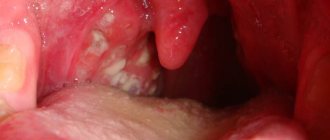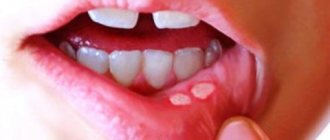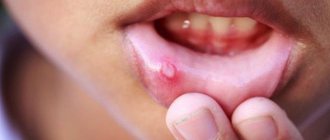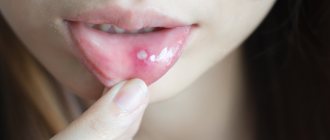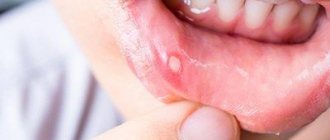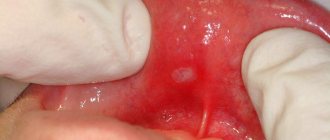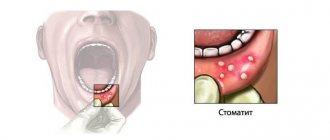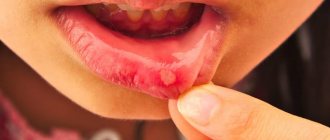Vincent's ulcerative-necrotizing stomatitis is a disease that affects the oral mucosa and is infectious in nature. It is caused by the complex action of spirochetes and fusobacteria. Painful ulcers appear in the patient's mouth, the temperature rises and general health deteriorates significantly. The patient feels muscle aches, headaches and constant mild nausea.
Clinical manifestations of the disease are necrotic and destructive processes affecting the oral mucosa. Most patients suffering from this pathology are men aged between twenty and forty years. The disease has a seasonal pattern - according to statistics, it is most often diagnosed between October and December.
Dentistry is also aware of cases of ulcerative-necrotizing stomatitis of a secondary nature - for example, in blood diseases.
What it is
Most often, the appearance of Vincent's stomatitis occurs in people with a low level of immunity, especially against the background of chronic diseases. Necrotizing stomatitis is one of the types of bacterial stomatitis with pronounced necrotizing ulcers affecting the soft tissues and mucous membrane of the mouth. Young people under thirty years of age are more susceptible to this disease, however, this does not mean that ulcerative necrotizing stomatitis does not manifest itself in other age categories.
The isolated course of this disease is extremely rare, since in most cases it is a complication of long-term diseases of the gastrointestinal tract or a logical continuation of untreated catarrhal stomatitis. In this case, the ulcerative form of the disease is characterized by damage to the mucous membrane to the entire depth of its layer with the possible formation of ulcers on the lips, the inside of the cheeks, on the gums, the soft and hard palate and on the tongue.
Chronic recurrent herpetic stomatitis
This form of stomatitis is directly related to infection, namely the herpes virus. This virus usually enters the body of an adult in early childhood (in this case, the disease can be practically asymptomatic and not be noticed), after which it settles in the body and remains with us for life. When immunity decreases and other factors favorable for the development of the disease coincide, herpes becomes more active, causing a characteristic picture of the disease.
Among the common causes contributing to the disease, it is worth noting:
- acute respiratory infections, acute respiratory viral infections, hypothermia (leading to a general decrease in immunity);
- seasonal vitamin deficiencies;
- stressful situations;
- allergies of various origins;
- exacerbation of chronic infections of ENT organs (tonsillitis, sinusitis);
- taking drugs that reduce immunity (corticosteroids, for example).
Local factors influencing the development of diseases include:
- injuries to the mucous membrane of the oral cavity and lips;
- soft plaque and tartar;
- infection living in carious cavities and periodontal pockets during gingivitis and periodontitis;
- mouth breathing (as a result of which the mucous membrane dries out and cracks).
Symptoms
- The total duration of the disease usually ranges from 10-14 days.
- General symptoms (headache, weakness, fever), if expressed, are not to a significant extent. There may be enlargement of the submandibular lymph nodes and their soreness.
In the mouth, herpetic stomatitis manifests itself as follows:
- Small (millet-sized) blisters appear on the bright red and swollen mucous membrane, which are usually located in groups.
- Favorite localization sites are lips, cheeks, tongue, palate and palatine arches.
- At the beginning, the contents of the bubbles are transparent, over time they become cloudy, and on the 2-3rd day the bubbles burst, forming erosions, which can be located separately, or can merge into a common erosion with uneven edges.
- Very quickly, a whitish or yellowish fibrinous coating forms on the surface.
- In addition to rashes, the clinical picture of gingivitis is often noted (redness, soreness and bleeding of the gum edge adjacent to the teeth and interdental papillae).
- Often, rashes in the mouth are duplicated by the same bubbles in the area where the edge of the lip meets the skin of the face and at the transition of the nasal mucosa to the skin.
- Outside, after opening the vesicles, a dense crust forms on their surface, which is not removed until the skin underneath has healed and does not leave scars after removal.
It is important to distinguish aphthous stomatitis from herpetic stomatitis, since their treatment is different!
If with aphthous stomatitis the mucous membrane surrounding the rash is unchanged, then with herpetic stomatitis it is bright red and swollen, with aphthous stomatitis there is one or two aphthae of the correct shape, and with herpetic stomatitis there are many small ones or they merge, forming erosion with uneven edges; with aphthous stomatitis there is no primary the appearance of bubbles, no rashes on the lips.
Treatment
- In the first days, antiviral drugs are prescribed in the form of gels and tablets orally. If no treatment was carried out in the first 3-4 days and the blisters have already burst, then antiviral drugs will be of little use in the future. Acyclovir (tablets or ointment), Viferon and other drugs can be taken at the pharmacy and used according to the instructions.
- Antiseptic rinses must also have antiviral activity (herbal decoctions, chlorhexedine and other traditional antiseptics are not used here). It is better to rinse your mouth with miramistin - it is active against the virus.
- Skin rashes are treated with antiviral ointments. Acyclovir, herpevir, Zovirax and other drugs for external use (use according to instructions).
- General treatment comes down to symptomatic correction of well-being (lowering the temperature, if any, drinking plenty of fluids), as well as immunostimulants.
- To heal erosions, from the 3-4th day, the same means are used as for aphthous stomatitis (vitamins A and E, sea buckthorn oil, solcoseryl).
- If erosions are significantly painful, use local anesthetics.
Causes
The most important and obvious reason for the development of any form of stomatitis is poor oral care. In the absence of proper sanitation and timely treatment of diseased teeth and gums, the risk of pathogenic Vincent spirochetes and spindle-shaped bacteria entering the resulting microcracks and damage to the mucous membrane increases. As a result of the symbiosis of these bacteria and their active reproduction, ulcers form in the mouth, and soft tissues undergo necrosis and decomposition.
Often the cause of the development of Vincent's gingivostomatitis is complications of such serious diseases as agranulocytosis, infectious mononucleosis, leukemia, poisoning of the body by prolonged exposure to heavy metal salts, and immunodeficiencies. In this case, favorable conditions for the development of ulcerative stomatitis are periodontal disease, gingivitis, periodontitis, dental trauma, untreated deep caries, tartar and even the eruption of wisdom teeth.
In addition, frequent smoking, drinking too hot drinks and food, stress and depression, and unfavorable working conditions contribute to the development of inflammatory processes.
Current and prospects
In accordance with the symptoms and their severity, experts distinguish acute, subacute and chronic forms of the disease, and according to the severity of the lesion - mild, moderate and severe forms.
With timely treatment of ulcerative stomatitis, the prognosis is usually favorable (weakening of the lesion within a few days, a significant reduction in the duration of the acute period, recovery within eight to twelve days). But if there is no treatment or if it is started late (advanced cases), complications are possible: damage to periodontal tissues, loosening and loss of teeth, and the disease becoming chronic.
Request a consultation
Symptoms
One of the most unpleasant signs of ulcerative stomatitis, in addition to severe pain, is a terrible smell from the mouth, which is formed due to rotting of the soft tissues. In some cases, ulcerative stomatitis is not limited to the oral mucosa and spreads deep inside, affecting many vital organs. In this case, the following symptoms appear on the face:
- sudden increase in body temperature, chills, fever;
- loss of strength, apathy, aches in muscles and joints;
- gums swell, become loose and red;
- severe pain when eating, drinking liquids and when trying to speak, which is why the patient is often silent and sometimes completely refuses to eat;
- Enlargement and tenderness of the cervical and submandibular lymph nodes;
- migraine type headaches;
- increased salivation;
- an increase in leukocytes in the blood according to test results;
- the number of ulcers is constantly increasing, the older ones are covered with a gray film, when removed, a deep bleeding wound that does not heal for a long time is exposed;
- there is constant bleeding of the gums;
- in rare cases, if left untreated, necrosis can affect not only soft tissues, but also the alveolar process, as a result of which teeth can be severely damaged and even fall out;
- if treatment is neglected, the causative bacteria can spread to the palatine tonsils, which can result in Simanovsky-Vincent angina in both adults and children.
Aphthous stomatitis in an adult
Causes
There can be several reasons for the appearance of aphthous stomatitis in an adult, and each of them can be either an independent cause of the disease or work in combination with the others. The most common causes of aphthous stomatitis are:
- Staphylococcus (a microorganism found in large quantities in dental plaque, in the microflora living in carious teeth and tartar, in tonsils during chronic tonsillitis);
- chronic pathology of the gastrointestinal tract (most often the liver);
- immunity disorders;
- allergies (of any origin).
Under the influence of these factors, local resistance to infection decreases, and opportunistic staphylococcus, which usually does not manifest itself, can give rise to inflammation with the formation of a typical element of the rash - aphtha.
Symptoms
- The duration of the disease is usually within 10-14 days.
- The general condition of this type of stomatitis is rarely disturbed (there may be a slight increase in temperature and enlargement of the submandibular lymph nodes).
- Characteristic formations – aphthae – appear on the mucous membrane. They are round spots, slightly raised above the level of the externally unchanged mucous membrane of the lips, gums or tongue, the diameter is 5-10 mm.
- Aphthae are covered with a white, yellowish or grayish fibrinous coating and are sharply painful when touched. There is a bright red rim of inflamed mucosa around the aphthae.
- Most often, aphthae are located on the cheeks or gums in the vestibule of the oral cavity, where the mucous membrane is often injured by food, but they can be under the tongue, on the tongue, on the palate and palatine arches.
- Usually the rashes are single or paired, less often there are more of them.
- Due to the severe pain of aphthae, hygiene and eating can be difficult.
Treatment
Treatment of aphthous stomatitis should take into account all possible causes of its occurrence, as well as promote rapid healing of aphthous stomatitis.
General events
- From the moment aphtha is detected, it is necessary to exclude all allergenic foods from the diet (citrus fruits, chocolate, honey, nuts), as well as exclude the possibility of drug allergies (if you are taking any medications, you should consult a doctor about replacing them with safer analogues) .
- If stomatitis appears frequently, then consultation with a therapist and specialized specialists is needed to exclude diseases of the gastrointestinal tract, endocrine system organs, ENT infections, as well as consultation with an immunologist.
Local treatment of aphthous stomatitis
- Treatment of the oral cavity with antiseptic solutions (solutions of Miramistin, chlorhexelin, furacillin, stomatidine, Givalex, Listerine, decoctions of medicinal herbs, etc.). Any antiseptics are acceptable. Many drugs are sold ready-made, some need to be diluted additionally - read the instructions.
- From the 4th day, treatment is carried out with epithelializing preparations (solutions of vitamins A and E, sea buckthorn oil, rosehip oil, solcoseryl, etc.).
- If eating and hygiene are difficult due to the pain of aphthae, then local anesthetics can be used before brushing teeth and eating (gels for infants used during teething - Dentol or its analogues).
- Sanitation of the oral cavity is mandatory (removal of roots that cannot be restored, treatment of caries and its complications, professional hygiene).
- Additionally, medications may be prescribed to enhance local immunity (consult your doctor before using such medications).
Treatment should be carried out only after consulting a dentist, since aphthous stomatitis can easily be confused with herpetic and prosthetic stomatitis, and the treatment for these forms of stomatitis is different.
Treatment
Bacterial causes of this disease require treatment with antibiotics, anti-inflammatory drugs and disinfectants. The most commonly prescribed medications are:
- Rinse and treat with a weak solution of hydrogen peroxide, furatsilin or potassium permanganate;
- Solutions of trypsin, pancreatin, chemotrypsin and other proteolytic enzymes to remove tissues susceptible to necrosis;
- Trichopolum, Flagyl, Metrogyl, Dioxidin or Klion for a week;
- General strengthening agents, immunomodulators, vitamin and mineral complexes to boost immunity;
- Antibiotics: ampiox, gentamicin, lincomycin, penicillin, kanamycin;
- Antihistamines to relieve possible adverse reactions from antibiotics;
- Keratoplasty: metacil, solcoseryl, retinol acetate, aloe and kalanchoe juice, sea buckthorn oil.
Your attending physician will tell you in detail at your dental appointment about how to treat ulcers on the tongue and soft tissues of the oral cavity. Proper treatment helps relieve the main symptoms within one to two days and heal the ulcers within a week.

